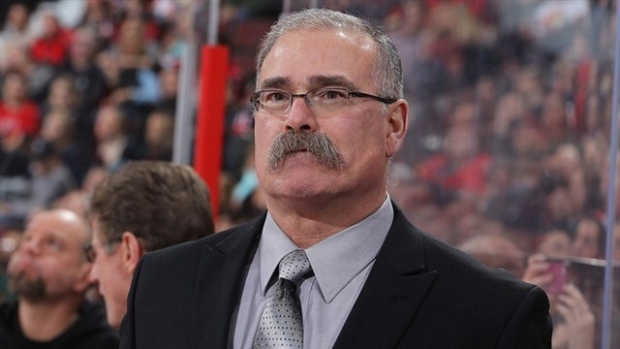Dec 9, 2014
Yost: MacLean a victim of his own success with Senators
Bryan Murray’s termination of Paul MacLean as Ottawa’s head coach on Monday morning wasn’t surprising. Many have fairly pointed out that Paul MacLean was likely a victim of his own success. Carrying two low-budget teams to the post-season in his first two years – and winning a Jack Adams Trophy in the process – set the benchmark high for future seasons. But, his team – comprised of many of the same players from those playoff-caliber clubs – has struggled mightily in the last season and a half.
By Travis Yost

Bryan Murray’s termination of Paul MacLean as Ottawa’s head coach on Monday morning wasn’t surprising. The team had won just four of its last fifteen games, and MacLean was already on the hot seat stemming from last season’s disappointing finish.
Ottawa’s general manager cited myriad reasons as to why the team decided to go in a different direction. Ultimately, he could have pointed to the club’s underlying numbers to illustrate rapidly depreciating performance from those playoff teams of yesteryear.
Many have fairly pointed out that Paul MacLean was likely a victim of his own success. Carrying two low-budget teams to the post-season in his first two years – and winning a Jack Adams Trophy in the process – set the benchmark high for future seasons. But, his team – comprised of many of the same players from those playoff-caliber clubs – has struggled mightily in the last season and a half.
One of the best ways to illustrate the nosedive that Paul MacLean’s team had taken over the last hundred or so games is to pull out Ottawa’s possession numbers using Fenwick% (all unblocked shot-attempts) and Corsi% (all shot-attempts, including those that were blocked) since his retention. We can use a 20-game rolling average to smooth out the results some. Remember, 50% would indicate an average possession team. The dotted line indicates the beginning of the 2014-2015 season.

I think the biggest takeaway from this graph is pretty simple. The “Pesky Sens” label handed out to the team during both playoff years also coincided with controlling more than 50% of the play over 82-games. The club earned a reputation as a scrappy bunch of overperformers, but for the most part, they were an above average hockey team. You’ll also notice three stretches of significantly positive play prior to the start of this year -- two of which likely triggered respective runs into the post-season.
This year (all things right of our vertical dotted line), there’s really no comparison. The team’s been on a steady nosedive contrary to prior Paul MacLean seasons. This is a team that’s indiscernible from the likes of Colorado, and by percentage points, closer to the likes of trying-to-lose-Buffalo than upstart Nashville. Strip away the league’s 5th-best save percentage (.922), and you’re likely talking about Ottawa as a very serious contender in the draft lottery.
To further investigate the dive in either of the above possession proxies (we will use Corsi% here), we can split the metric into ‘shot attempts for’ and ‘shot attempts against’. For years, Paul MacLean’s teams have been featured fantastic shot generation, but poor shot suppression. If we use the same 25-game rolling averages for CorsiFor (per 60) and CorsiAgainst (per 60), can we pick up which of the two significantly deviated?
I’ve created a mid-line of 54 – the average number of shot attempts a team takes (or yields) per 60-minutes.

I think this graph is pretty telling. Ottawa’s always played with frenetic pace under Paul MacLean – both their CorsiFor and CorsiAgainst per 60 are, for the most part, significantly higher than what we would note as the league average.
This season, the CorsiFor per 60 has plunged, but the CorsiAgainst per 60 is consistent with what we have seen in years past. Now, if you wanted to troubleshoot the issue further, you’d probably focus on why the team isn’t generating enough offensively as opposed to why they concede so many shots against – the former is a new issue, the latter has been an issue since Paul MacLean took over in October of 2011. Ultimately, though, it’s a combination of the two that ended in his firing.
It’s probably worth noting that, unlike many head coaching firings, there are a considerable number of arguments to be made in support of Paul MacLean. To start, MacLean was dealt a team with the league’s smallest payroll. The money Ottawa did spend included extensions for two aging-out veterans in Chris Phillips and Milan Michalek, and a three-year extension for a fifth-round defenseman who, at the time of the deal, had logged 21 NHL games. The team also bet on two young defensemen in Jared Cowen and Patrick Wiercioch, neither of whom have lived up to expectations.
Paul MacLean didn’t simply forget how to coach, and his teams historically have been above average at 5-on-5. Can the significant drop-off solely be attributed to his coaching style, or is it possible that a newfound talent drag has been the impetus behind Ottawa’s demise?
The front office is betting that MacLean was the issue – they’ve consistently defended the talent on their roster, and clearly they believe his style was depressing the collective performance of the team. Only time will tell if that’s an accurate assessment.


